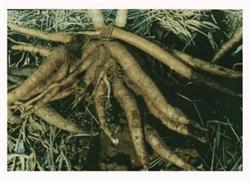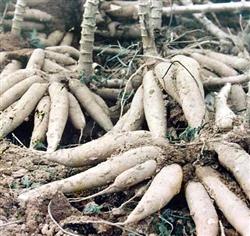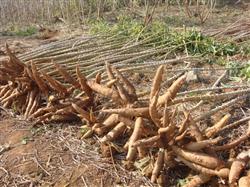High-yield cultivation techniques of cassava

Cassava has a wide range of uses. In addition to food and feed, cassava is also an important raw material for the production of starch, modified starch, wine and grain, glucose, fructose, sorbitol, lysine, citric acid, dyes, coatings, cosmetics and other industrial products. Product value is high and demand exceeds supply. Cassava is coarse and easy to grow, adaptable, fertile, barren land and slopes can also be planted. Under general cultivation conditions, the yield per mu can reach about 2 tons, and if the management can be strengthened, the yield per mu can reach more than 3 million tons. If interplanting watermelons, the output value per mu of legume crops can be increased by more than 300 yuan, and the output value per mu can be increased by about 1300 yuan. First, land selection and land preparation: cassava has strong adaptability and low requirements for soil conditions, and can be planted in places where there is no serious stagnant water or drought. However, in order to obtain higher yield per mu, it is better to choose sandy loam with sufficient sunshine, deep soil layer, loose vegetables and rich organic matter. Soil preparation: require deep ploughing and raking, deep ploughing 27mur30cm, if ploughing and harrowing is difficult to reach this depth, the method of border can be used to thicken the soil layer. 2. Selection of seed stem and its treatment: the selection standard of cassava seed stem is fully mature, strong dense node, fresh and solid, complete bud point, no skin damage, not dry, not ripe and rotten, disease-free, cortical green, and the middle and lower segments of the main stem with milk flow through the cut are the best. Seed stem treatment: after selecting the seed stem, cut the cassava seed stem into small segments according to every 2 effective buds (do not let the epidermis break and damage the bud eyes), soak and disinfect the truncated seed stem with benzoyl ammonium or lime water, requiring stem cutting, disinfection and planting on the same day. Third, cultivation method 1. Pure breed: cassava is generally pure and easy to manage, but the land utilization rate is low and the output rate is low. 2. Interplanting and interplanting: the growth of cassava is slow in the early stage, and the rows of cassava are sparse and transparent, so it is suitable to popularize intercropping and interplanting. Intercropping and intercropping do not affect the growth and development of main crops, but also benefit the growth of cassava, increase multiple cropping index per unit area, improve light energy and land utilization rate, increase yield per unit area and improve economic benefits. Intercropping mainly consists of watermelon, pumpkin, zucchini, red melon seeds, peanuts, soybeans (4476, 19.00, 0.43%), mung beans and other short-stalk crops with a short growth period, and can also interplant early corn (2323, 5.00, 0.22%), or interplant among young fruit trees. 3. Plastic film mulching cultivation improves the ecological conditions of the soil plough layer, coordinates the relationship between water, heat, air, fertilizer and soil microorganisms, and plays the role of heating, water conservation, soil conservation, fertilizer conservation and grass prevention. It can be planted early at the end of February and early March, promote early germination and early growth, reduce soil moisture evaporation, keep the soil moist and loose, and is beneficial to cassava growth and root growth. Increase the output by more than 30%. The method is as follows: on the ploughed land, start the border according to the row spacing (1 meter), and mix the needed fertilizer in the middle of the border and the soil at one time (generally applying 500ml / mu farm fertilizer, 25kg compound fertilizer, 20kg nitrogen fertilizer, 25kg potash fertilizer, 25kg phosphate fertilizer), covering the border with 1 meter wide plastic film (about 5 kg per mu, the market price is 6.6 yuan / kg, and the mu investment is about 33 yuan). The soil was compacted around the plastic film, and then the cassava seed stem was cut into both sides of the border film according to the plant distance (0.8Mui 1 meter). The seed stem exposed 3 Mel 5 cm from the ground. Pay attention to the choice of plastic film planting after rain or when the land is wet to ensure the germination rate of the seed stem. Fourth, the main cultivation techniques of open field planting (1) selection of improved varieties. Cassava King, South China 124,124 selected, Luyute, GR911, Nanzhi 199, Brazil 7, Brazil 2, Nanzhi 105, Xinxuan 056, Xinxuan 01, etc. Through the experiment, these varieties are more than 16% higher than the original varieties, and they are the more high-yielding varieties in our city at present. (2) apply sufficient base fertilizer. The suitable proportion of cassava to nitrogen, phosphorus and potassium is N:P:K=2:1:2-3, and potassium fertilizer can obviously increase the yield of cassava. The basic principle of fertilization is to apply sufficient base fertilizer, early application of strong seedling fertilizer, re-application of tuber fertilizer, and proper application of strong potato fertilizer. The general application of basic fertilizer is 25 kg of phosphate fertilizer per mu, 500 kg of farm fertilizer, 750 kg of farm fertilizer and 15 kg of compound fertilizer. (3) sowing seeds at the right time. The seeds can be sown when the daily average temperature is above 15 ℃. If the temperature is too low and cannot germinate in the soil for a long time after planting, it will dry up or mildew and lose the ability to germinate. It is usually planted in the first and middle of March in our city. (4) planting methods. The planting methods of cassava are flat, oblique cuttage and straight cutting. The three methods have their own advantages and disadvantages. Oblique insertion method or flat method is used in production, and the flat method is labor-saving and fast, tuber is shallow, horizontal distribution, easy to harvest, but sprouting slowly, easy to lack plants. This method is suitable for the soil with shallow and thin topsoil and firm subsoil. The oblique insertion method has the advantages of fast and neat seedling emergence, high seedling emergence rate, potato extension in one direction, more convenient harvest, but poor wind resistance and easy lodging. (5) reasonable close planting. The planting density of cassava depends on soil fertility and variety. The general planting density is 600ml 1000 plants / mu. The row spacing is 0.8-1 m × 1 m. For varieties with fertile soil or strong branching, the planting distance can be wider, the soil fertility is poor or the plant type is erect, it can be planted closely. (6) Field management. 1. Seedling replenishment. In order to ensure the whole seedling, the missing seedlings should be replenished in time, which usually starts 20 days after planting and is completed within 30 days. All replanted seedlings should be fertilized immediately after survival in order to catch up with the general growth. 2. Mianmiao. There are usually 4 or more buds unearthed after cassava planting. If they are allowed to grow, there will be multiple main stems in each hole, which will cause shading and nutrient consumption. Generally, the seedlings should be carried out when the height of the seedlings is 15 mi 20 cm, and it is appropriate to leave 1 Mel 2 seedlings in each hole. 3. Ploughing and weeding. The root tuber of cassava needs loose and well-ventilated topsoil to develop well. Therefore, weeding in the middle tillage within three months after planting is a key period to promote block growth and increase yield per plant. Generally, 40 days after planting, when the seedling height is 15ml / 20cm, weeding can be carried out for the first time to promote the growth of seedlings. The second intertillage weeding can be carried out 70 days after planting. 100 days after planting, the third time of ploughing and loosening soil can be carried out if necessary. 4. Topdressing. 60 days after planting, when the seedling height is 20ml and 30cm, strong seedling fertilizer should be applied as early as possible, urea 7.5 kg per mu and potash fertilizer 5ml 7kg per mu to promote the growth of seedlings neatly and sturdily; from May to July, when the seedling height is 60ml 90cm, it can be combined with mid-ploughing and weeding, re-application of tuber fertilizer, promotion of tuber production and increase of potato number, urea 10kg and potash fertilizer 15kg per mu. From September to October, when the seedling height is 100ml and 130cm, combined with the work of cultivating soil and preventing wind, a small amount of strong potato fertilizer is properly applied, and potassium sulfate (or potassium chloride) 5Mel 7kg per mu. The method of fertilization is to open a ditch and cover the soil. 5. Look at the spraying of paclobutrazol on the top and tender parts of cassava. For cassava with sufficient fertilization and excessive seedling potential, the cassava can be sprayed with paclobutrazol 2 package + potassium dihydrogen phosphate 1 and 30 jin of water respectively at the seedling height of 30ml 50cm, 80m 100cm and 130m 150cm, respectively. (7) Prevention and control of diseases and insect pests according to the occurrence of diseases, pests and rodents, timely prevention and control (8) timely harvest and seed stem storage 1. Harvest of cassava. The mature characteristics of cassava are that the leaves turn yellow, the old leaves fall off at the base, the skin of the tuber is thick, and the appearance becomes darker. When the outer skin of the cassava is easy to take off, it indicates that it is ripe and can be harvested. 2. Seed stem storage. Burying method: the stem should be harvested before frost. The method is to choose the place where the leeward is facing the sun and the position is high without stagnant water, and dig into a pit 30-50 cm deep with a hoe, the width depends on the length of the stem, and the length is determined as needed, generally no more than 15 meters, and the height is about 1 meter. Put the seed stem neatly in the pit, cover 5 Mel 10 cm soil, form an arch back shape, leaving 3 Mel 5 ventilation holes.
- Prev

Early and rational fertilization of cassava
At present, the cultivation and management of cassava is extensive, there is no distinction between the good and the bad, the yield is low and the economic benefit is poor. In order to obtain high yield in cassava cultivation, the following comprehensive techniques must be adopted: first, selecting improved varieties and improving the coverage rate of improved varieties is the key technology to increase the per unit yield and total yield of cassava. The yield of improved varieties.
- Next

High yield of cassava, good planting and good seedlings
Apply enough base fertilizer. Many people plant cassava on mountains and dry land without applying basic fertilizer and grow anywhere, so the yield is very low. In order to improve the planting efficiency of cassava, we should first turn the ground well, plant distance 1 meter, make good holes, and apply enough mixed fertilizer such as chicken manure, plant ash, waste mud and so on, with a large bowl per hole to lay a good foundation for seedling emergence and long potatoes. Choose a good one.
Related
- The first cup of black tea in spring, the flavor and history of tea gardens in Kenya, Africa
- The computer can not only choose potatoes, but also grow tea rice. AI will grow winter oolong tea champion.
- It is not only the inflated tea bitten by insects, but also engraved with the four seasons tea in Beipu.
- The Oriental Beauty Tea Festival in Zhuxian County takes the stage at the weekend to experience the plus-size feast of oil tea.
- & quot; Oriental Beauty Tea & Exploration of Emei in Hsinchu, the hometown of quot;
- The new variety of strawberry "Tainong 1" dessert is the first choice with mellow aroma. Crimson gorgeous
- History of Tea in Taiwan: from Wild Inner Mountain to Export Tea Garden
- Two types of Taiwan Oriental Beauty Black Tea won the British three-Star Award for Childhood Tea Xiang Zhang Jiaqi changed from pilot to champion tea maker.
- Banana species and varieties: the planting history of Taiwan Xianren banana and dwarf banana is long, is banana disease resistant?
- Coffee planting Technology: Qianjie Coffee from Seedling to harvesting

